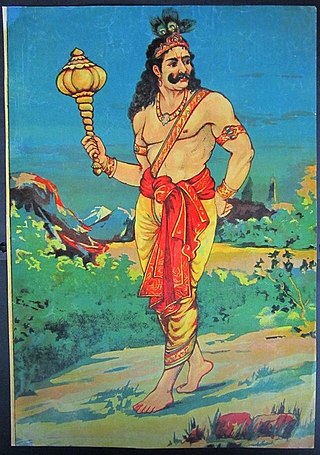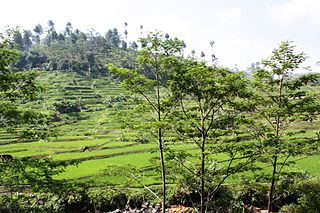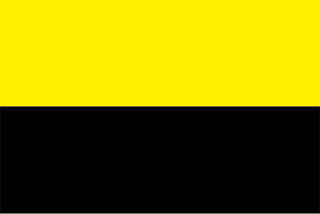Related Research Articles

In Hindu epic Mahabharata, Bhima is the second among the five Pandavas. The Mahabharata relates many events that portray the might of Bhima. Bhima was born when Vayu, the wind god, granted a son to Kunti and Pandu. After the death of Pandu and Madri, Kunti with her sons stayed in Hastinapura. From his childhood, Bhima had a rivalry with his cousins Kauravas, especially Duryodhana. Duryodhana and his uncle, Shakuni, tried to kill Bhima multiple times. One was by poisoning and throwing Bhima into a river. Bhima was rescued by Nāgas and was given a drink which made him very strong and immune to all venom.

Sri Sultan Hamengkubawono X is the Sultan of the historic Yogyakarta Sultanate in Indonesia and is currently also the Governor of the modern Yogyakarta Special Region.

Sultan Anyakrakusuma is known as Sultan Agung was the third Sultan of Mataram in Central Java ruling from 1613 to 1645. He was a skilled soldier who conquered neighbouring states and expanded and consolidated his kingdom to its greatest territorial and military power.
Negara Daha was a Hindu kingdom successor of Negara Dipa that appears in the Hikayat Banjar. It was located in what is now the Regency of Hulu Sungai Selatan, Province of South Kalimantan, Republic of Indonesia.

Amangkurat I was the susuhunan of the Mataram Sultanate from 1646 to 1677.

Tasikmalaya Regency is a regency in the province of West Java, Indonesia. With an area of 2,708.82 km2 (1,046 sq mi), it is the biggest and most important in the southeast region of East Preanger. Tasikmalaya had a population of 1,687,776 in the 2010 census and 1,865,203 in the 2020 census; the mid-2022 official estimate was 1,906,288.

Sunan Giri, Muhammad Ainul Yakin (born 1442 CE in Blambangan is considered one of the Wali Sanga of Indonesia.

The Salakanagara Kingdom is the first historically recorded Indianised kingdom in Western Java. The kingdom existed between 130-362 AD. Claudius Ptolemaeus wrote about Java in his book, Γεωγραφικὴ Ὑφήγησις. He mentions the lands of Chryse and Argyre in Labadio. According to some historians, e.g. Edi S. Ekajati, Labadio means Dwipa-Javaka, Dwipa-Javaka or Java Dwipa, which is the ancient name of Java Island. At the time, the Salakanagara kingdom ruled west Java and its name means “Silver Nation” in old Sundanese language. According to some theories, Ptolemaeus may have visited Java in 160 AD. A more recent source, from the 17th century, Pustaka Rajya Rajya i Bhumi Nusantara describes Salakanagara as being founded by an Indian merchant from Pallava Kingdom.
Ciung Wanara is a legend among Sundanese people, Indonesia. Ciung Wanara was actually a nickname of Prince Manarah of Sunda–Galuh Kingdom. He was a relative of the famous King Sanjaya of Mataram.

The Sunda Kingdom was a Sundanese Hindu kingdom located in the western portion of the island of Java from 669 to around 1579, covering the area of present-day Banten, Jakarta, West Java, and the western part of Central Java. The capital of the Sunda Kingdom moved several times during its history, shifting between the Galuh (Kawali) area in the east and Pakuan Pajajaran in the west.

The Sultanate of Cirebon was an Islamic sultanate in West Java founded in the 15th century. It is said to have been founded by Sunan Gunungjati, as marked by his letter proclaiming Cirebon's independence from Pajajaran in 1482, although the settlement and the polity had been established earlier, in 1445. Sunan Gunungjati also established the Sultanate of Banten. It was one of the earliest Islamic states established in Java, along with the Sultanate of Demak.

Sultanate of Banjar or Sultanate of Banjarmasin was a sultanate located in what is today the South Kalimantan Province of Indonesia. For most of its history, its capital was at Banjarmasin.

Madiun Regency is a landlocked Regency in East Java province, Indonesia. It covers an area of 1,010.86 km2, and had a population of 662,278 at the 2010 Census and 744,350 at the 2020 Census. It is bordered by Bojonegoro Regency in the north, Nganjuk Regency in the east, Ponorogo Regency in the south, and Magetan Regency and Ngawi Regency in the west, while the city of Madiun is an enclave within the regency.

Prince Antasari, also known by his Indonesian name Pangeran Antasari, was a sultan of Banjar and is a National Hero of Indonesia. His son Prince Hijrah is one of the leaders of The Navy.
Medang Kamulan was a semi-mythological kingdom that is believed to be once established somewhere in Central Java according to Javanese mythology. It is either perceived as the predecessor or the actual historical kingdom of the Medang Kingdom. "Kamulan" is derived from the word "mula" in Javanese and means "origin", hence "Medang Kamulan" can be interpreted as "pre-Medang" or "Medang the origin".
Genta Buana Paramita is an Indonesian production house founded in 1995 by Budhi Sutrisno. It is an Indonesian Film & TV Series production company.
Tutur Tinular is an Indonesian historical-drama radio series. Consists of 24 chapters with a total of 720 episodes, it was first aired in January 1989. At its prime, it was aired on 515 radio stations in Indonesia with millions of listeners. It was adapted to movies from 1989-1992. It was then adapted into a TV series produced by Genta Buana Pitaloka and first aired on ANTV on October 25, 1997.

Panembahan Senapati, formally styled Panembahan Senapati ing Ngalaga Sayyidin Panatagama, was the founder of the Mataram Sultanate.

Lengger is a traditional Javanese dance originating from Banyumas, Central Java, Indonesia. This dance is played in pairs, between a man and a woman. Lengger dance is one of the sacred dances in Java.
References
- ↑ "Acara Televisi Jadul (In Indonesian)". Forum Detik.com.